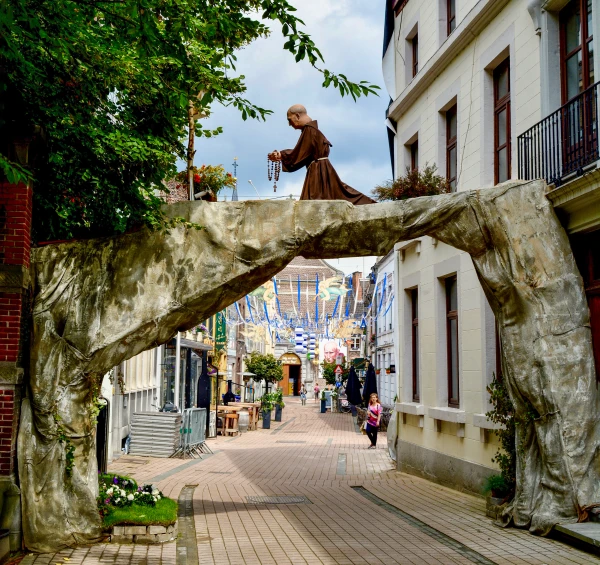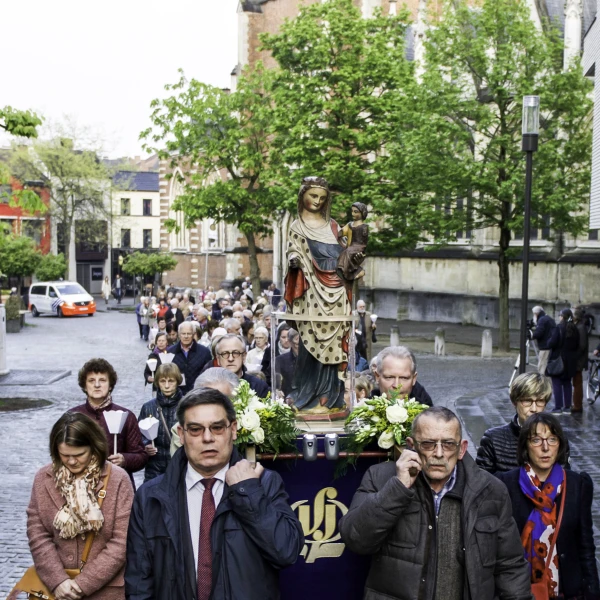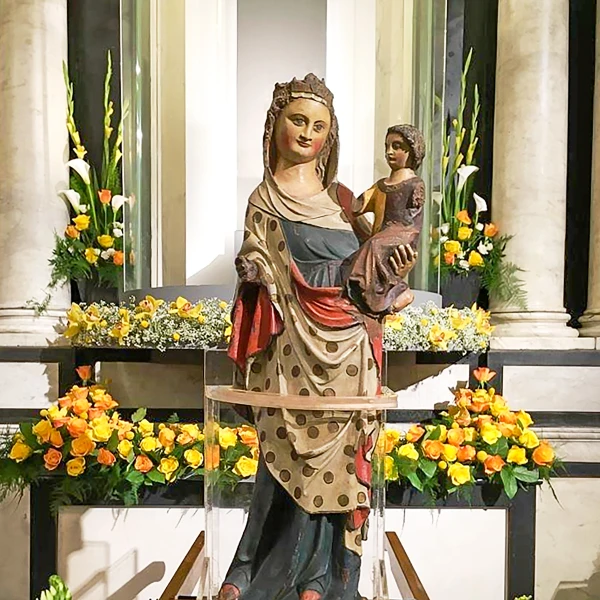Paris, France, Aug 10, 2024 / 07:00 am
For the past 340 years in the town of Hasselt in northeastern Belgium, people have been celebrating a major Marian event every seven years — honoring the “Virga Jesse” through processions, liturgies, and cultural initiatives. This year, tens of thousands of people are expected to attend the 47th gathering Aug. 11–25.
“Virga Jesse,” which translates to “stump of Jesse,” is an ancient term for the Virgin Mary. In the Old Testament, the prophet Isaiah predicts the birth of Christ with these words: “A branch will come forth from the stock of Jesse, father of David; a shoot will spring from his roots” (Is 11:1). Christian tradition has given Christ’s mother, a descendant of the tribe of David, the salutation of “Jesse’s root.”
The septennial celebration of Virga Jesse is part of a tradition of Marian processions in the Meuse-Rhine Euroregion, bringing together part of Flanders in Belgium, the southeastern part of Holland, and the western part of Germany. Septennial festivities are held in Tongeren (Belgium), Susteren (Holland), and Aachen (Germany).

This year, the town of Hasselt in Belgium has organized the festivities around its Marian statue in the Basilica of Our Lady. The Gothic oak statue of Mary has been venerated in Hasselt since the 14th century, and the tradition of septennial feasts began in 1682.
About 3 feet high and polychrome, this precious sculpture is loaded with symbolism. The tunic of the infant Jesus, a mixture of yellow and brown, refers to the divine and the earthly, according to the official website of the Virga Jesse in Hasselt.
The roots of the celebration
The people of Hasselt are very attached to their Madonna, who has been invoked in times of calamity over the generations. The Madonna of Hasselt received official recognition in a story recounted on the festivities’ website.
During the winter of 1867, rinderpest, a contagious viral disease affecting cloven-hoofed animals, severely affected Hasselt’s herds, threatening the survival of the distillers of jenever (the ancestor of modern gin), a local specialty, due to their use of horses. As they had done for centuries, the people of Hasselt took refuge at the foot of the Virga Jesse, initiating a novena.
The disease was beaten and the inhabitants, moved by a deep gratitude to their patroness, asked the Vatican to crown the Virga Jesse. Rome agreed, and on Aug. 15, 1867, the statue was given such honors by the visit of a papal representative, Monsignor Xavier de Merode, in the center of the city.
This history has further strengthened the resolve of the town’s inhabitants to come together every seven years to celebrate Virga Jesse.
“It’s a spiritual tradition but also a cultural one,” Luc Vandeweyer, head of communications for Hasselt’s Virga Jesse Committee, told CNA. “The festivities are centered on the Virgin Mary, but many initiatives have been developed in the neighborhoods, with ornaments, tableaux vivants in the streets.”
While Vandeweyer acknowledged that Catholicism “has become less fashionable in recent decades” in Belgium, he said he is delighted that this Marian tradition is still “alive and kicking.”
“We manage to gather over 1,300 participants for each procession, based on episodes from the life of Mary,” he said.

For months, eight groups have been preparing texts, songs, and dances illustrating the life of the Virgin Mary around themes such as openness to God, joy, faith, eternal love, hope, and gratitude, with the help of the organizing Virga Jesse Committee in Hasselt and a professional producer.
(Story continues below)
For the first time, participants were able to actively contribute to the content and shaping of the procession this year. The committee reserved space for interviews with participants in the program booklet written for festival visitors. For example, the oldest man in the procession — who is 97 years old — will be following the procession in a wheelchair. There is also the story of a family participating with four generations of women — grandmother, daughter, and granddaughter pregnant with a daughter.
The organizing committee itself has about 20 members and 250 volunteers in August who coordinate three processions around the Virgin on Aug. 15, 18, and 24 as well as the music, costumes, decorations, and security for the celebrations. Each procession attracts about 20,000 visitors alone.
The ‘miracles’ of Virga Jesse
In the streets of Hasselt, paintings will depict the “miracles” performed by the patron saint of Hasselt — and there are many miraculous events attributed to Virga Jesse.
Tradition says that a child playing in a garret fell out of a window and was found dead on the cobblestones by his mother. Bringing the child to the statue of Virga Jesse, the mother obtained from the Virgin a return to life for her son.
In another story, “L’homme errant,” a native of Hasselt named Christianus set off on a pilgrimage to Rocamadour in France. One night, he wandered into a forest, always ending up in the same place, unable to find his way back. In extreme distress, he cried out: “Virga Jesse, save me!” And suddenly he felt the Virgin Mary take him by the hand and lead him to safety.

In another miraculous story surrounding the Virga Jesse, on the night of Aug. 16, 1659, a thief broke into the basilica, lured by the gold and silver jewels, precious stones, and lace dresses covering the statue of the Virgin. The thief filled a bag with the loot and climbed the fence between the choir and the transept when he realized that he was strangely stuck on the fence, despite all his attempts to flee. This is where the police found him.
Another miracle dates to the Second World War. On the night of Nov. 3–4, 1944, a bomb destroyed a large part of the church housing the Virga Jesse. However, the statue was found intact under the rubble.

This year’s festivities
In addition to the above-mentioned processions, some 50 prayer services, 100 concerts, 70 theatrical performances, and a dozen exhibitions will take place between Aug. 11 and Aug. 25.
One not-to-be-missed tradition is the distribution of “pea soup,” which takes place in the square in front of the basilica under the eye of the “Langeman” — a 16-foot-tall statue of a giant from local tradition, which only comes out of its cellar for Virga Jesse festivities or the arrival of a new Belgian king.
All this is completed by the “rotten,” the traditional name in English for 45 street committees of Hasselt’s inner-city districts who decorate the city’s streets and squares with flags, flowers, works of art, pennants, and ribbons hung from trees. These same groups also take care of depicting all of the “miracles” surrounding the town’s beloved Virga Jesse.






